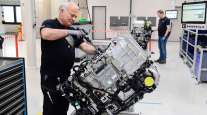Senior Reporter
Volvo Sees Q3 Profit, Revenue Fall but Notes Improvement Near End of Quarter

[Stay on top of transportation news: Get TTNews in your inbox.]
Volvo Group posted third-quarter declines in net income and revenue, reflecting a drop in deliveries even though truck orders rose.
For the period ended Sept. 30, Volvo — which reports in Swedish krona — reported net income of $670 million, or 32 cents per diluted share, compared with $860 million, or 42 cents, a year earlier.
Revenue fell to $8.8 billion compared with $11.2 billion in the 2019 period.

Lundstedt
“Toward the end of the quarter, transport activity was back on roughly the same level as a year ago in most markets. This led to an improved sentiment among our customers, which is reflected in increased order intake for trucks, engines and construction equipment, as well as a gradually improving service business,” Volvo Group CEO Martin Lundstedt said in a statement.
Truck revenue fell 26% to $5.5 billion compared with $7.3 billion a year earlier.
Lundstedt said with the easing of COVID-19 restrictions, there were increasing levels of freight activity, and customers are returning to previously planned replacement cycles.
Volvo reported North American order intake increased 151% to 12,441 trucks compared with 4,966 a year earlier, with good demand across most segments compared with a year earlier. That was especially true for regional-haul and longhaul trucks. In 2019, order activity was low as dealers had excess inventory.
Truck deliveries in North America decreased by 57% to 6,121 in the quarter. Volvo Trucks’ heavy-duty market share through September increased to 9.5%, up from 9.3% a year earlier. Mack Trucks’ market share increased to 7%, up from 6.8%.
Volvo Trucks North America and Mack are Volvo brands based in Greensboro, N.C.
Lundstedt noted Volvo continues to invest in truck technologies that are electrified, automated and connected.
Volvo began selling battery-electric trucks in March in Europe and now is moving ahead in North America, he said.
Volvo has started piloting the electric regional-haul truck Volvo VNR Electric with customers in Southern California, and serial production of the truck is scheduled to begin in 2021.
At the same time, its Mack Trucks brand is making inroads with electrified trucks in the refuse segment, including in the New York City Department of Sanitation and Republic Services. Serial production of the Mack LR Electric also will begin next year.
He said Volvo’s alliance with Isuzu and the creation of the fuel-cell joint venture with Daimler Trucks are progressing and “signing of final contracts are planned before year-end.”
In December, Volvo announced it intended to transfer ownership of its complete UD Trucks business globally to Isuzu Motors to accelerate growth by leveraging greater volumes and complementary capabilities.

Over the past few episodes, we've had the chance to listen to the experiences of industry leaders and the strategies and planning that go into finding the right people for your workforce. Host Michael Freeze reviews the most important bullet points, from technician and driver training to incorporating diversity in recruitment and retention. Hear a snippet, above, and get the full program by going to RoadSigns.TTNews.com.
In April, Daimler Truck AG and Volvo Group reached a preliminary agreement on a joint venture to develop, produce and commercialize fuel cell systems in heavy-duty vehicles by the second half of the decade.
Meanwhile, Volvo Group’s cash and cash equivalents amounted to $9.8 billion on Sept. 30 compared with $7 billion on Dec. 31.
On Sept. 30, Volvo Group had 96,229 employees, including temporary employees and consultants, which was a decrease of 9,340 employees compared with a year earlier.
The number of blue-collar employees decreased by 3,933 while the number of white-collar employees decreased by 5,407.
During the third quarter the number of employees decreased by 847. The number of blue-collar employees increased by 292 while the number of white-collar employees decreased by 1,139. The increase in blue-collar employees was related to increased production levels.
Want more news? Listen to today's daily briefing:
Subscribe: Apple Podcasts | Spotify | Amazon Alexa | Google Assistant | More





